No.3  May 2007 May 2007 | ||
 |
Crop Prospects and Food Situation | |
|
FAO’s global cereal supply and demand Indicators point to another tight seasonEarly signs that global cereal supply and demand will be closely balanced in the new season (2007/08) are further confirmed by the leading indicators used by FAO for its regular assessment of world cereal market conditions. 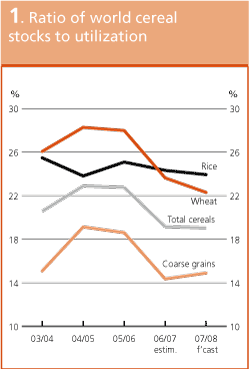
The ratio of world cereal ending stocks in 2007/08 to the trend world cereal utilization in the following season is forecast to remain virtually unchanged from the low level of the previous year at 19 percent. Surging utilization, which is expected to again exceed trend in 2007/08, is likely to absorb most of the anticipated gain in world 2007 cereal production, hence keeping world ending stocks and consequently this ratio at very low levels. The world wheat stocks-to-use ratio is forecast to decrease to 22.3 percent, slightly below the already reduced level in 2006/07 and well under 34 percent observed during the first half of the decade. Also for rice, the ratio is seen to decline further, to about 24 percent. However, for coarse grains, the ratio is expected to register a small increase from 2006/07, which was the lowest level since the early 80s, to around 15 percent. 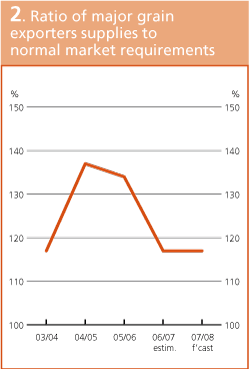
Based on the latest production forecasts and assuming normal growing conditions to prevail, aggregate supplies of the major grain exporters in 2007/08 are expected to exceed their normal market requirements by just 17 percent, unchanged from the previous season, and a relatively low level, considering the figure was over 30 percent in the mid-2000s. This indicates no expected change in the ability of these exporters to meet the global demand for wheat and coarse grains imports and points to a likely continuation of a tight market situation in the new season. 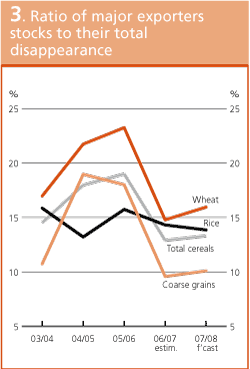
The ratio of the major exporters’ ending wheat stocks to their total disappearance is expected to increase slightly in 2007/08 from the 2006/07 low. However, at only 16 percent, the wheat ratio would remain precariously low, and any significant deterioration in the 2007 production from current forecasts, which is still possible, could have serious implications for the supply/demand outlook. For coarse grains, the ratio is also expected to increase slightly but to remain low at 10 percent. The fast growing demand for biofuels is expected to keep maize exportable supplies at exceptionally tight levels even with a record harvest that is anticipated in the United States, the world’s largest maize producer and exporter. For rice, the ratio is expected to decline slightly to about 14 percent as total supplies in major rice exporting countries are anticipated to rise marginally. 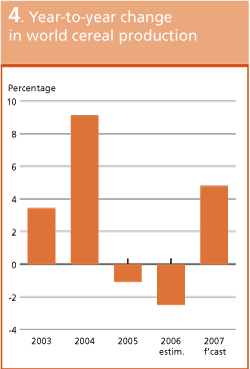
World cereal production is forecast to increase by about 5 percent in 2007, which would represent a strong rebound after two consecutive years of contraction. This is a positive development for the world cereal supply/demand balance, in view of the tightly balanced situation shown by the first 3 indicators. However, with the harvests of many important 2007 cereal crops still several months off and some yet to be sown, this forecast remains very tentative and a deterioration in the coming months cannot be ruled out. 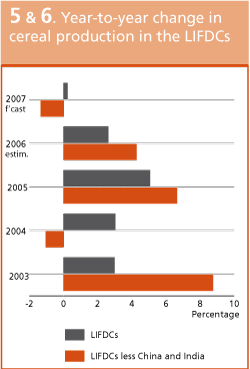
Following four years of sustained growth, the cereal production of LIFDCs in 2007 is forecast to increase only marginally from 2006, which means a less comfortable supply situation in the new 2007/08 season. Excluding China and India, which account for some two-third of the aggregate cereal output, production in the rest of LIFDCs would decline by 1.3 percent after two consecutive years of substantial increases. Lower cereal crops than last year are in prospects in LIFDCs in Southern and North Africa, while in other regions where the new agricultural seasons are just beginning, outputs are expected to drop from last year’s bumper levels. This, coupled with population increases, is likely to result in several LIFDCs resorting to larger imports to cover their consumption needs. 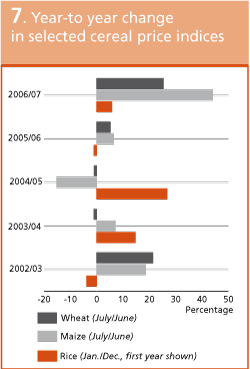
The tightening of the global cereal balance in 2006/07 has pushed up prices of all cereals. In the case of wheat, the price index during the first 8 months of the current marketing year (July 2006 to April 2007), has averaged 25 percent above the average for 2005/06. For maize, the price surge has been even more significant with the index rising by nearly 44 percent. For rice, a modest 6 percent increase was registered in 2006 but prices continue their upward trend since the start of 2007. These increases have contributed to a significant rise in the cereal import bill of the LIFDCs which is forecast to jump 26 percent from 2005/06 to reach US$23 billion in 2006/07. Given the prospect for strong international prices again in 2007/08, a more burdensome season may lie ahead for the LIFDCs, especially for those countries needing larger imports to cover domestic production shortfalls. This is a development which FAO will continue to monitor closely. 1 The first indicator is the ratio of world cereal ending stocks in any given season to world cereal utilization in the following season. Utilization in 2008/09 is a trend value based on extrapolation from the 1997/98-2006/07 period. 2 The second indicator is the ratio of the exporters’ grain (wheat and coarse grains) supplies (i.e. a sum of production, opening stocks, and imports) to their normal market requirements (defined as domestic utilization plus exports of the three preceding years). The major grain exporters are Argentina, Australia, Canada, the EU and the United States. 3 The third indicator is the ratio of the major exporters’ ending stocks, by cereal type, to their total disappearance (i.e. domestic consumption plus exports). The major wheat and coarse grain exporters are Argentina, Australia, Canada, the EU and the United States. The major rice exporters are India, Pakistan, Thailand, the United States, and Vietnam. 4 The fourth indicator shows the aggregate cereal production variation from one year to the next at the global level. 5&6 In view of the fact that the Low-Income Food-Deficit Countries (LIFDCs) are most vulnerable to changes in their own production and therefore supplies, the FAO’s fifth indicator measures the variation in production of the LIFDCs. The sixth indicator shows the annual production change in the LIFDCs excluding China and India, the two largest producers in the group 7 The seventh indicator demonstrates cereal price developments in world markets based on changes observed in selected price indices. |
| GIEWS | global information and early warning system on food and agriculture |